#IndigenousFramework
Text
Indigenous Framework Art Collection unveiled at City Hall
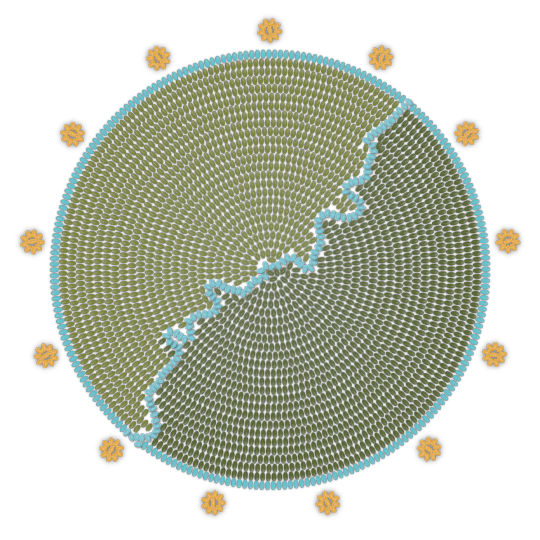
Indigenous Framework Logo by Tashina Makokis.
The City of Edmonton’s Indigenous Framework was built on years of dialogue with Indigenous communities, while seeking to answer the question, "How can the City of Edmonton best support and build strong relationships with Indigenous Peoples in Edmonton,” These conversations included formal and informal relationships with Elders, community Knowledge Keepers, and Indigenous youth, as well as information gathering from research and discussions with municipal and community leaders, service providers, and academic professionals.
In 2019, Indigenous artists Melissa-Jo (MJ) Belcourt Moses, Brad Crowfoot, Dawn Marie Marchand and Lana Whiskeyjack were invited by the City of Edmonton to capture the spirit of the Indigenous Framework community conversations and tell a story through creation of a visual art piece. The collection of completed artworks embody how City leaders and staff should strive to honour the spirit of kinship, the Indigenous Framework roles and commitments, and how to be a good relative to each other and to the land. The public display of the Indigenous Framework art collection in City Hall is a direct response to the Indigenous Framework, Truth and Reconciliation Commission and MMIWG2S+ commitments and actions to ensure the resurgence of Indigenous cultures and histories in city spaces.
As the artworks are unveiled at City Hall, we asked the participating artists and Jaimy Miller, Director of Indigenous Relations at the City of Edmonton, to reflect on their work and what it means to be involved in this project.
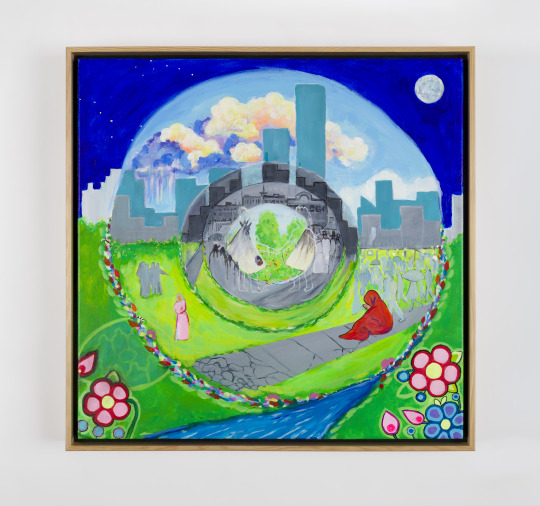
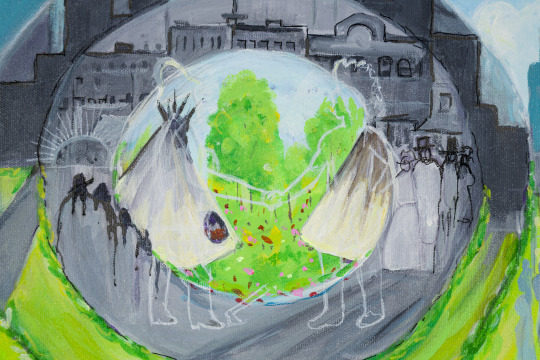
PISISKAPAHTAM (to notice and observe or watch) by Lana Whiskeyjack. Photos by Dwayne Martineau.
Your artworks were all inspired and informed by the results of the community engagement process for the Indigenous Framework. What about that process and what you learned, made its way into your individual work?
Lana: As the community members gathered to share about PISISKAPAHTAM, I listened and responded through live painting. Their stories of cultural memories braiding in their experiences of racism, violence, and poverty in the city provoked my experiences as nehiyaw iskwew. Our collective stories were translated through the colours and images.
MJ: I started my art piece just prior to Covid–19. Feeling the pressure to get it finished, I asked my niece Bella Stonehouse to sort beads for the 14 rows. Time was limited, so my friends Debbie Houle and Sherryl Sewepagaham offered to thread beads. Half-way through the threading and stitching, news of Covid struck and we were forbidden to be in close quarters. My social work-bee came to an end. Sheryl brought me some toilet paper, and with masks to cover our faces, we bumped elbows goodbye.
Under the strains and confines to the Covid outbreak I learned that my strongest ties to the Indigenous arts community emerged from my long-standing connections and friendships.
Overall connection to community is the significance that comes from the creation of the art itself, people coming together, assisting, and contributing what they can do to complete the work. Though we were not able to meet, I still felt supported and encouraged to complete my piece.
Dawn Marie: I recreated the facilitation notes and flip charts of the community engagement process. When I looked at it, I looked for themes and recurring statements until the structure presented itself. It’s all their words just reorganized. Upon reviewing all the support materials, it was clear that the conversations at the various tables centred around four main themes; financial support, staff/training, ombudsman/advocacy office and culturally safe space/s.
Several symbols such as horses and hoof prints symbolize concerns and barriers brought forward by Indigenous community members like financial support and sustainable funding. The movement of horses, for example, represents how the City must collaborate with Indigenous communities in Edmonton to ensure actions reflect diverse voices and perspectives. Other symbols like the circles represent the need for continuous education and training and self-reflection of personal beliefs, attitudes, and assumptions leading to action against racism towards Indigenous Peoples. The intent of the artwork is for City staff to put these teachings into practice in the workplace. For a deeper understanding, there is an artwork guide on the City’s Indigenous Framework webpage.
Brad: One of the themes that came out of the community engagement was Treaty. One point made was, Treaty was the original framework, and this inspired me to use the kohkum scarf and the colours: yellow, blue and green. For as long as the sun shines, the river flows and the green grass grows. We are all treaty people.
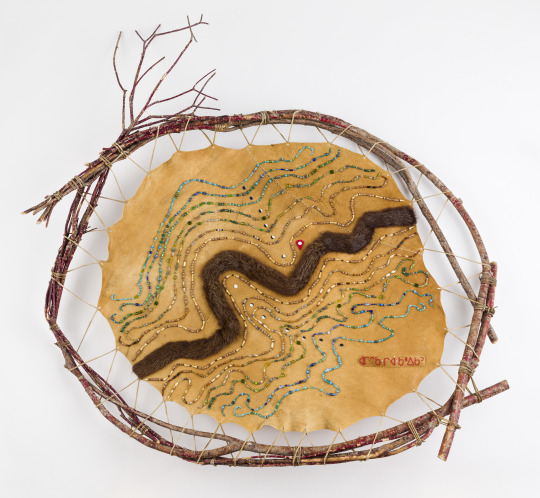

ᐊᒥᐢᑲᐧᒋᐋᐧᐢᑲᐦᐃᑲᐣ Amiskwaciy-wâskahikan by MJ Belcourt-Moses. Photos by Dwayne Martineau.
What does it mean to you as an artist to have your artwork on display in City Hall?
Lana: As a nehiyaw iskwew visual storyteller, my intention is to contribute to the diverse decolonial stories of courage for our future generations. To have the municipal leadership collectively agree to provide City Hall walls to carry the collective visual stories of Indigenous peoples is an act of reconciliation.
MJ: It’s an honour and a privilege to represent my ancestral ties through a creative lens that ties me to land. Presenting my perspective to a wider audience about our relationship to land and stories connect us to where we are from and who resides within these parameters. We are here, tied to place we call home ᐅᑳᐁᐧᒫᐊᐧᐢᑭᕀ [okâwîmâwaskiy] -- mother earth. It is my hope that the 7th generation still has beauty to breathe deeply in.
Brad: For someone who was born and raised in Edmonton and to see City Hall host numerous events and have many very talented artists on display and their work showcased. I feel honoured to be apart of them and to see my work alongside the other artists who contributed to this project. It gives you a feeling of validation as an artist.
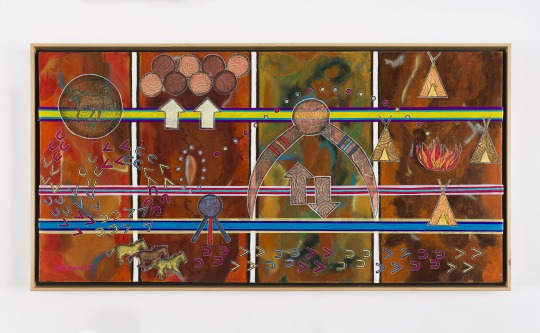

City as an Advocate by Dawn Marie Marchand. Photos by Dwayne Martineau.
What message about the Indigenous Framework do you want to share with our arts and cultural communities?
Lana: The amount of mental, emotional, and physical labour to collect, share and mobilize these stories of Indigenous relatives is a great gift to the city. I am proud to live in a city that listens and governs with action to create good relations for our future generations.
Dawn Marie: I’m grateful that there was a well-rounded engagement process.
MJ: Connection is vital... get to know each other. Go to an art exhibit, buy some Indigenous art, listen/read Indigenous storytellers, have tea with an Elder. If we are visitors to these lands or if this is the land of our forefathers, we must show respect for the giving and sharing.
Brad: My art piece has bit of the past with the kohkom scarf, a symbol of how Indigenous peoples adopted the Ukrainian scarf as their own showing great respect towards the Ukrainian community. Parts of the present with the Beaver Hills House Park art installation shows the City of Edmonton working with Indigenous communities to showcase our art in public displays. I added the seven teachings, to look into the future with an Indigenous lens if we want true reconciliation.
Jaimy: The Indigenous Framework was developed through a co-creative process with community members, organizational partners, and Elders, youth, and artists. Working with Indigenous artists presented a wonderful opportunity to capture the intentions, the feelings, and the statements of community in a visual representation. Their artwork is a reflection of community, of our city, and speaks to the four roles that the city of Edmonton is striving to live out - to be a listener, a partner, a connector, and an advocate and to build positive meaningful relationships with Indigenous peoples in Edmonton.
One of our commitments in the Indigenous Framework is to create safe welcoming spaces for and with Indigenous people, and to ensure that Indigenous communities see themselves reflected in city spaces and places. Art plays a fundamental role in creating a sense of place, identity, and connection to community.


Heart Beat of a Nation by Brad Crowfoot. Photos by Dwayne Martineau.
Is there anything else you wish to share?
Lana: Please be a better relative. Nohkom would say, “Speaking, walking, talking and supporting with kindness is one the best ways to being a better human.”
Dawn Marie: Thanks for the chance to show alternative ways to knowing and showing story.
Brad: I would like to thank MacEwan University for this opportunity to be involved in this project. Even the community engagement was held there, where I met and listened to what people had to say. I included the Poundmakers Singers, a photo that was taken as they sang for MacEwan’s unveiling of their Treaty 6 marker.
Jaimy: I am so thrilled to see these artworks have a home in City Hall and be displayed for all Edmontonians and all leaders now and in the future that will walk through these halls. I hope that people will take the time to view the art and reflect on the gifts of the artists, and the messages within their art. And of course, I encourage people to read the Indigenous Framework at edmonton.ca/indigenousframework
About the artists
Lana Whiskeyjack
Dr. Lana Whiskeyjack is nehiyaw iskwew (Cree woman) scholartist (scholar and artist) from Saddle Lake Cree Nation and is an associate professor in the Department of Women's and Gender Studies in the Faculty of Arts, University of Alberta. Dr. Whiskeyjack demonstrates innovative interdisciplinary knowledge translation and mobilization through arts-based practices, community-engaged research, scholarship services and teaching. As a graduate from the first Indigenous governed educational institution in North America and former Indian Residential School, in the iyiniw pimâtisiwin kiskeyihtamowin doctoral program at University nuhelot’įne thaiyots’į nistameyimâkanak Blue Quill, she has an excellent record of research/creative dissemination that is grounded within nêhiyaw (Cree) ceremony, nêhiyawêwin (Cree language) and nêhiyaw worldview.
Dawn Marie Marchand
Dawn Marie Marchand is a member of Cold Lake First Nation in Treaty Six territory. cîpêhcakwawêw-iskwêw (Blue Horse Spirit Woman) is a Cree and Metis artist, educator, advocate, author, writer, speaker, and mother. Her many noted accomplishments include Circle of Courage Coordinator for the Alberta Indigenous Games in 2011, Co-founder and lead organizer of Cree8 Success Conference in 2012, art installations for the Edmonton Folk Festival in 2013 called “Monto”; Edmonton City Hall in 2014 during the Truth and Reconciliation Gathering “A Place to Hang your Stories”; co-producing the Walrus Talks-Aboriginal City art components in 2015, “Edmonton Treaty 6 Soccer ball”; and Redx Talk “Art is the Medicine” in 2016; and an installation called “The Longest Journey” as part of the Nuit Blanche Festival in 2018. She received an Aboriginal Role Model Award for Art in 2017, during her term as the First Indigenous Artist In Residence for the City of Edmonton, facilitated the Indigenous Artist Market Collective engagement and launch in 2018. In mid 2019, she relocated to Smoky Lake, AB. Since then she has had work installed in Concordia College, Indigenous Knowledge and Research Centre, Stanley Milner EPL, PÎYÊSÎW WÂSKÂHIKAN. She has had her work projected as part of Dreamspeakers Light Strikes in numerous locations including Dubai and has recently had work projected as part of the Land Acknowledgment during the Junos celebrations in 2023. She was the artist consultant for Punctuate! Theatre's "First Métis Man of Odessa" which is currently touring nationwide. She continues to advocate for removing systemic barriers for Indigenous artists across Canada.
MJ Belcourt Moses
MJ is a traditional Métis artist, certified Native Cultural Art instructor and most recently served as Indigenous Art Consultant for Fort Edmonton Park and Indigenous Curator for the Edmonton Public Library. In 2019, MJ served as an Indigenous Artist in Residency with the City of Edmonton.
“I have a keen interest in the promotion and education of Indigenous Arts that relate to our cultural life locally, provincially and nationally… Indigenous People rich contribution to Canada’s history and heritage reflects perseverance, strength and resilience - Art celebrates the achievements.”
Brad Crowfoot
Brad Crowfoot is a Blackfoot and Navajo multi-media artist, born and raised in Edmonton. He’s been active within the arts scene for almost 20 years and is known for capturing Indigenous arts, culture and entertainment through photography and digital media. He went to school for Arts and Cultural Management at MacEwan University and was involved with kihêw waciston as part of the Indigenous Student Council Executives. He got involved with the City of Edmonton and the Indigenous Framework to help showcase the City as a partner.
3 notes
·
View notes